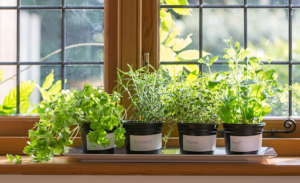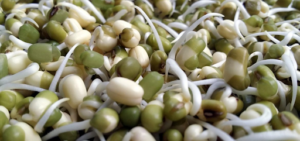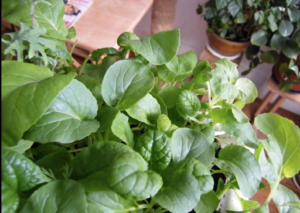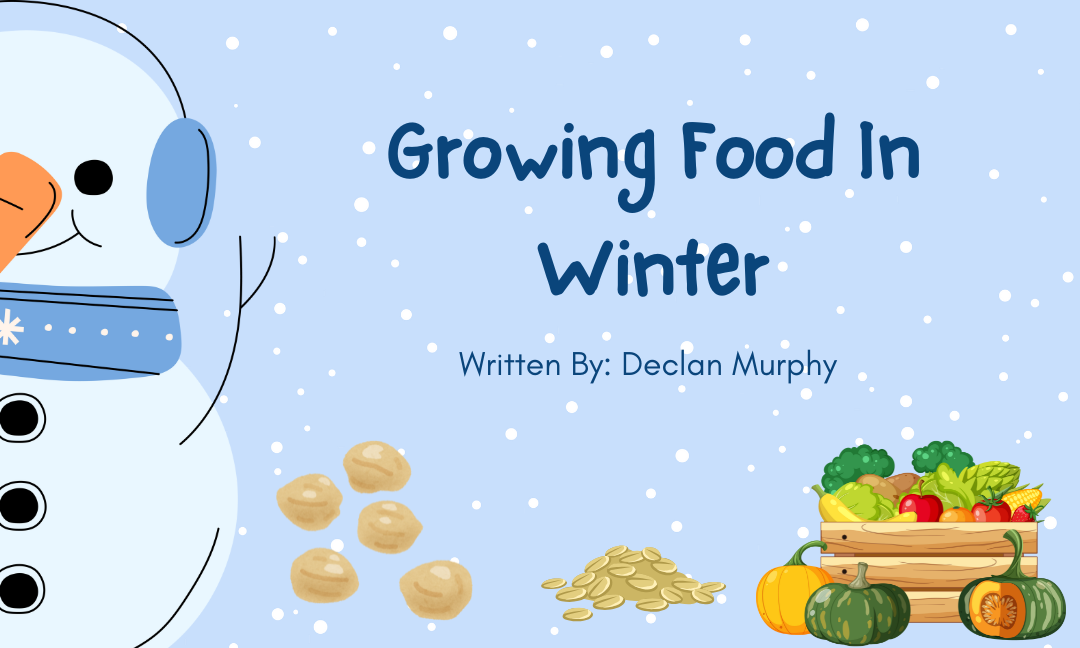Written by: Declan Murphy
Edited by: Rayna Almas
Designed by: Eshika Hiremath
Published by: Rayna Almas
Gardening is a wonderful way to increase food sovereignty, but full scale gardening is impossible for most of us through the cold months of winter. In this post, we will consider a few ways that we can produce our own food at home all year long!

Indoor Herb Gardens
Probably the easiest, most classic way to bring gardening indoors is to keep an indoor herb and/or tea garden on the windowsill.
Online, you can find a number of indoor herb garden kits, but you don’t need to buy a lot of equipment to make this work as long as you have a few window sills and some patience.
Herbs are generally quite easy to start from seed, and can be grown in small pots or even cups. All you need is soil, seeds and water, with a window that provides adequate light for growing plants. An organic plant food suitable for indoor plants will also keep your plants healthy and more productive if used as directed.
Some popular indoor herbs for beginners include mint, parsley and sage, and all of these can be harvested fresh as needed throughout the year.
Adding freshly cut herbs to your cooking will bring spring into your kitchen all winter long!

Grain, Seed and Bean Sprouts
A less well known, but probably more nutritious, option is seed sprouting at home. Similar to herb gardens, you can find seed sprouting trays and kits online that may make this activity easier for you, but these things are not necessary.
For most seeds, grains and beans, you can use simple household items and purchase the seeds from most health food stores. One simple way to sprout your seeds, grains or beans is to soak them overnight, drain and rinse them, and then place the wet seeds into a mason jar covered with cheesecloth. Rinse and drain your seeds gently once a day for 2 to 4 days (or slightly longer, depending on the seed), and, in the end, you will have sprouted seeds to eat! As long as the sprout is as long as the seed, you’re good to go!
Popular options for sprouting include mung beans, alfalfa seeds, rice, broccoli seeds, black beans, millet, or green lentils.
Sprouting grains, beans and seeds is a great way to produce fresh food all year long. Sprouts tend to be very high in nutrition compared to their calories, and often contribute a good deal of protein or fibre to your diet. One cup of mung bean sprouts pack 3 grams of protein and 2 grams of fibre with 0 fat and only 31 calories! 1 cup of alfalfa sprouts are only 8 calories, and give you a major source of vitamins K and C.
Bean and most seed sprouts can be eaten fresh as a salad, or in sandwiches, or can be added to stir fries and other cooked meals. (Grain sprouts are usually mashed or ground into flour for making tortillas or breads.) They are quick and easy, and produce a “crop” in just a few days, making them an incredible source of nutrients throughout the year.

Fresh Greens All Year Long!
Just like fresh herbs, you can have fresh salad greens all year long through indoor gardening. Lettuce, spinach, and arugula all grow well indoors and can produce edible greens in just 5 or 6 weeks. You can grow multiple “generations” by planting and replanting a new tray every week, so that when you harvest one another will become ready, and so on. Many varieties let you snip off leaves here and there to keep the plant producing for a while.
Like your herb garden, you will simply need potting soil and containers, with water, plant food, and a source of light. Your lettuce trays or bowls might be a bit too big for your window sills, however, so a plant table near a well lit window might work better. You can also buy affordable grow lights, if you need them, to make this DIY winter food project work best for you in your home.
Greens are essential for human health, and can be quite expensive in winter. With a little effort, you can have a pretty and nutritious garden in your kitchen or living room for delicious salads all winter long!
And, remember – even gardening starts long before the summer! Over the winter, you can plan your garden and start your seedlings indoors beginning in February or March, depending on what you are going to grow. In the fall, you get the fun of preserving seeds, and canning your harvest. Most gardeners would say that gardening is a full year occupation. However, in this post we have added a few active ways you can produce foods over the winter, as well, and we hope you give them a try!
If you have other ideas, please share in the comments.
Sources:
Anon. (2024.) “How to Grow Herbs Indoors.” Home Depot. https://www.homedepot.com/c/ai/how-to-grow-herbs-indoors/9ba683603be9fa5395fab9007657d9c.
Bonneau, A.M. (2017.) “How to Sprout Beans, Grains and Seeds.” Zero Waste Chef. https://zerowastechef.com/2017/02/09/sprout-grains-seeds/.
Boyles, M. (2023.) “Growing Lettuce Indoors Under Lights.” Farmer’s Almanac. https://www.almanac.com/grow-your-own-salads-indoors-all-winter.
Han, E. (2023.) “How to Make Sprouted Grains.” The Kitchen. https://www.thekitchn.com/how-to-make-sprouted-grains-cooking-lessons-from-the-kitchn-204466.
Jones, T. (2023.) “Alfalfa.” Healthline. https://www.healthline.com/nutrition/alfalfa.
Mikstas, C. (2022.) “Bean Sprouts: Nutritional Information.” WebMD. https://www.webmd.com/diet/health-benefits-bean-sprouts.
Sinha, A. (2023.) “For Sprouted Mung Beans, Just Soak, Rinse, and Wait.” bon appetit.
https://www.bonappetit.com/story/how-to-grow-mung-bean-sprouts.
Tallon, P. (2015.) “Growing a Winter Indoor Salad Garden – The Basics.” Growing North. https://growingnorth.ca/2014/12/growing-a-winter-indoor-salad-garden-the-basics/.
Whole Grains Council. (n.d.) “Sprouted Whole Grains.” Oldways Whole Grains Council. https://wholegrainscouncil.org/whole-grains-101/whats-whole-grain-refined-grain/sprouted-whole-grains.

